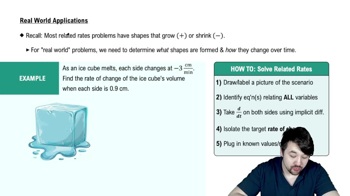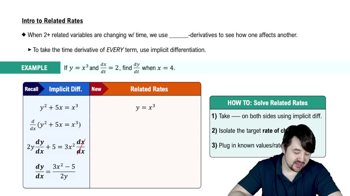Table of contents
- 0. Functions7h 52m
- Introduction to Functions16m
- Piecewise Functions10m
- Properties of Functions9m
- Common Functions1h 8m
- Transformations5m
- Combining Functions27m
- Exponent rules32m
- Exponential Functions28m
- Logarithmic Functions24m
- Properties of Logarithms34m
- Exponential & Logarithmic Equations35m
- Introduction to Trigonometric Functions38m
- Graphs of Trigonometric Functions44m
- Trigonometric Identities47m
- Inverse Trigonometric Functions48m
- 1. Limits and Continuity2h 2m
- 2. Intro to Derivatives1h 33m
- 3. Techniques of Differentiation3h 18m
- 4. Applications of Derivatives2h 38m
- 5. Graphical Applications of Derivatives6h 2m
- 6. Derivatives of Inverse, Exponential, & Logarithmic Functions2h 37m
- 7. Antiderivatives & Indefinite Integrals1h 26m
- 8. Definite Integrals3h 25m
4. Applications of Derivatives
Related Rates
Problem 3.11.21
Textbook Question
A spherical snowball melts at a rate proportional to its surface area. Show that the rate of change of the radius is constant. (Hint: Surface area=4πr².)
 Verified step by step guidance
Verified step by step guidance1
Start by expressing the surface area of the snowball in terms of its radius using the formula for the surface area of a sphere: A = 4πr².
Since the snowball melts at a rate proportional to its surface area, we can write the rate of change of the volume V of the snowball as dV/dt = -kA, where k is a positive constant of proportionality.
Substituting the expression for surface area into the volume change equation gives us dV/dt = -k(4πr²).
Next, recall the formula for the volume of a sphere, V = (4/3)πr³, and differentiate it with respect to time t to find dV/dt in terms of dr/dt: dV/dt = 4πr²(dr/dt).
Now, set the two expressions for dV/dt equal to each other: 4πr²(dr/dt) = -k(4πr²), and simplify to find the relationship between dr/dt and the constants involved.
Recommended similar problem, with video answer:
 Verified Solution
Verified SolutionThis video solution was recommended by our tutors as helpful for the problem above
Video duration:
4mPlay a video:
Was this helpful?
Related Videos
Related Practice






